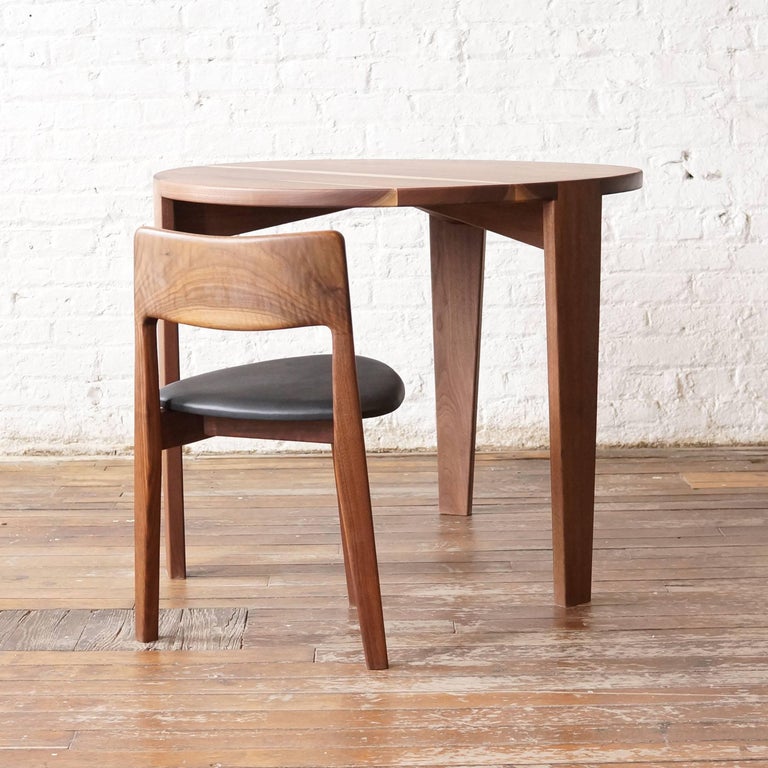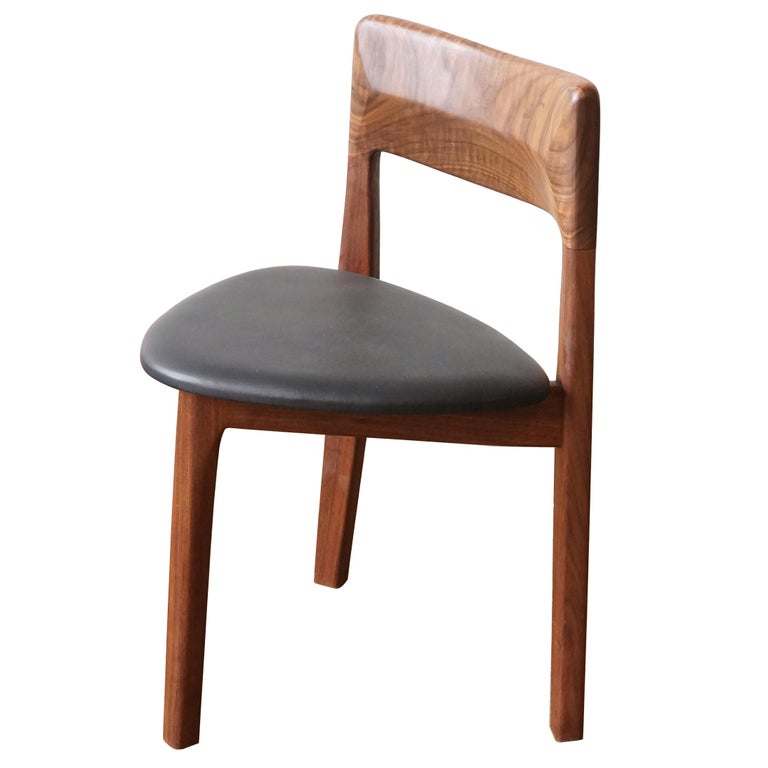The History and Origins of Three-Legged Dining Chairs

The three-legged chair, a seemingly simple design, boasts a rich history intertwined with human civilization’s evolution. Its origins can be traced back to ancient times, and its enduring popularity reflects its practicality, stability, and often, its elegant simplicity.
The three-legged chair, also known as a “tripod stool,” has roots in ancient civilizations. Its origins are likely intertwined with the development of early furniture, as humans sought more comfortable and stable seating options.
Ancient Origins, Three legged dining chair
The earliest evidence of three-legged chairs comes from ancient Egypt, dating back to the Old Kingdom period (c. 2686-2181 BCE). These chairs, often crafted from wood and decorated with intricate carvings, served as seats for royalty and elite members of society. The three-legged design offered stability and ease of movement, making them suitable for both indoor and outdoor settings.
The popularity of three-legged chairs extended to other ancient civilizations, including the Greeks and Romans. The Greeks, known for their love of beauty and craftsmanship, incorporated three-legged chairs into their architecture and art. These chairs, often made from marble or bronze, served as both functional seating and decorative elements.
Medieval and Renaissance Eras
During the Medieval and Renaissance periods, the three-legged chair continued to evolve, reflecting the changing styles and preferences of the time. While still commonly used, it was often overshadowed by more elaborate and ornate chairs, such as the high-backed chairs popular among the aristocracy. However, the three-legged design persisted, particularly in simpler forms, often used by the common people.
The 18th Century and Beyond
The 18th century witnessed a renewed interest in the three-legged chair, as the Enlightenment era emphasized practicality and simplicity. Designers and artisans embraced the elegant lines and timeless appeal of the three-legged design, creating variations that incorporated both traditional and contemporary elements.
Notable Three-Legged Dining Chairs
The history of three-legged dining chairs is filled with iconic examples, each showcasing unique features and designs. Here are a few notable instances:
- The Chippendale Chair: Thomas Chippendale, a renowned English furniture maker, created a variety of three-legged chairs during the 18th century. These chairs, known for their intricate carvings and elegant proportions, became a hallmark of the Chippendale style, which emphasized both practicality and aesthetics.
- The Windsor Chair: Originating in England in the 18th century, the Windsor chair is a classic example of a three-legged dining chair. Known for its simple yet sturdy construction, often featuring a curved back and a saddle seat, the Windsor chair remains a popular choice today.
- The Shaker Chair: The Shakers, a religious sect known for their craftsmanship and simplicity, produced a distinctive three-legged chair characterized by its minimalist design and functionality. These chairs, often made from wood and featuring a simple, straight back, exemplify the Shakers’ commitment to practicality and beauty.
Design and Functionality of Three-Legged Dining Chairs

The three-legged dining chair, a timeless design, embodies simplicity and elegance. Its minimalist structure, with a single point of contact at each leg, presents a unique set of design challenges and advantages.
Stability and Functionality of Three-Legged Chairs
The stability of a three-legged chair relies on a fundamental principle in physics: the triangle’s inherent rigidity. A triangle, unlike a quadrilateral, cannot be deformed without altering the length of its sides. This inherent stability makes three-legged chairs surprisingly robust despite their seemingly delicate construction.
The stability of a three-legged chair is also influenced by the chair’s center of gravity and the angle of its legs. A chair with a low center of gravity and legs that converge at a wider angle will be more stable than a chair with a higher center of gravity and legs that converge at a narrower angle.
Advantages and Disadvantages of Three-Legged Chairs
Advantages
- Stability: As mentioned earlier, the triangular structure provides inherent stability, making three-legged chairs less prone to wobbling compared to four-legged chairs.
- Space Utilization: The three-legged design allows for a more compact footprint, making them ideal for smaller dining spaces. The absence of a fourth leg provides greater flexibility in placement and movement, allowing chairs to be easily tucked under tables or moved around without obstruction.
- Aesthetics: The minimalist design of three-legged chairs lends itself to a wide range of styles, from traditional to modern. The absence of a fourth leg creates a clean, uncluttered look that can complement various dining room decors.
Disadvantages
- Limited Adjustability: Unlike four-legged chairs, three-legged chairs typically lack adjustable features such as swiveling or rocking mechanisms, limiting their versatility.
- Susceptibility to Uneven Surfaces: The three-legged design can make the chair more susceptible to wobbling on uneven surfaces. A slight unevenness in the floor can cause the chair to tilt or rock.
- Potential for Tipping: While generally stable, three-legged chairs can be more prone to tipping over if leaned against too forcefully or if a significant weight is applied to one side.
Types of Three-Legged Dining Chair Designs
The design of a three-legged chair can vary significantly, reflecting different aesthetic preferences and functional considerations.
Variations in Leg Shapes
- Straight Legs: The most common leg shape, straight legs offer a clean and minimalist look.
- Tapered Legs: Tapered legs provide a sense of visual lightness and elegance, while also contributing to the chair’s stability by widening the base.
- Curved Legs: Curved legs can add a touch of sophistication and fluidity to the chair’s design, creating a more organic and graceful aesthetic.
- Splayed Legs: Splayed legs, which diverge outwards from the seat, create a wider base, enhancing stability and providing a more substantial visual presence.
Materials
- Wood: A classic choice for three-legged chairs, wood offers durability, natural beauty, and a wide range of finishes.
- Metal: Metal legs can provide a sleek and modern look, with options including steel, aluminum, and iron.
- Plastic: Plastic legs offer affordability and a lightweight construction, often found in contemporary and minimalist designs.
Overall Construction
- Traditional Construction: Traditional three-legged chairs often feature a solid wood frame with mortise-and-tenon joints, providing robust and durable construction.
- Modern Construction: Modern three-legged chairs often employ lighter materials and simpler construction techniques, such as welded metal frames or molded plastic seats.
Modern Applications and Trends in Three-Legged Dining Chairs: Three Legged Dining Chair

The resurgence of the three-legged dining chair in modern design is a testament to its enduring appeal and adaptability. Beyond its historical significance, this simple yet elegant form has captured the imagination of contemporary designers, who are pushing the boundaries of materials, sustainability, and aesthetics.
Innovative Materials and Sustainable Practices
The use of innovative materials and sustainable practices has become a defining characteristic of modern three-legged dining chairs. Designers are exploring a wide range of materials beyond traditional wood, including:
- Recycled Plastics: These chairs offer a sustainable and eco-conscious alternative, transforming waste into functional and stylish furniture.
- Bio-based Composites: Composed of natural fibers and resins, these materials offer a renewable and biodegradable option, reducing reliance on traditional wood sources.
- Metal Alloys: Lightweight and durable, these alloys, often combined with sustainable finishing processes, add a contemporary edge to three-legged designs.
Emerging Design Aesthetics
Modern three-legged dining chairs showcase a diverse range of design aesthetics, reflecting the evolving tastes and preferences of contemporary consumers. Some prominent trends include:
- Minimalism: Characterized by clean lines, simple forms, and a focus on functionality, minimalist three-legged chairs embody a sense of restraint and elegance.
- Geometric Patterns: Bold geometric patterns, often incorporated into the chair’s legs or backrest, add a touch of dynamism and visual interest to the design.
- Organic Shapes: Inspired by natural forms, these chairs feature flowing curves and rounded edges, creating a sense of warmth and comfort.
Integration into Modern Dining Spaces
Three-legged dining chairs have seamlessly integrated into diverse modern dining spaces, demonstrating their versatility and adaptability.
- Mid-Century Modern: Their sleek lines and simple forms complement the iconic designs of this era, creating a cohesive and timeless aesthetic.
- Industrial Chic: Metal-framed three-legged chairs with exposed welds and raw finishes blend seamlessly with the industrial aesthetic, adding a touch of ruggedness and authenticity.
- Contemporary: Their minimalist designs and use of innovative materials perfectly align with the contemporary focus on simplicity, functionality, and sustainability.
Renowned Designers and Manufacturers
Several renowned designers and manufacturers specialize in creating innovative and stylish three-legged dining chairs, showcasing their unique approaches and design philosophies.
- Eames: The iconic Eames DSW chair, a three-legged design, remains a timeless classic, blending functionality and elegance.
- Arne Jacobsen: Known for his minimalist designs, Jacobsen’s Series 7 chair, with its three legs and contoured shell, embodies Scandinavian simplicity and functionality.
- Vitra: This Swiss manufacturer collaborates with leading designers to create innovative three-legged chairs, pushing the boundaries of materiality and design aesthetics.
Three legged dining chair – Three-legged dining chairs offer a unique aesthetic, often associated with minimalist or Scandinavian design. Their stability, however, can be a concern for some. For a more traditional yet elegant solution, the barlow tyrie mercury dining chair provides a robust and timeless design.
While not three-legged, its elegant silhouette and sturdy construction offer a different kind of stability and sophistication for any dining space.
Three-legged dining chairs, with their unique design and minimalist aesthetic, can add a touch of modern flair to any dining space. To elevate the comfort of these chairs, consider adding pier one chair cushions dining , which offer a range of styles and colors to complement your décor.
Whether you prefer a sleek, contemporary look or a more traditional feel, these cushions can transform your three-legged dining chairs into a haven of comfort and style.
